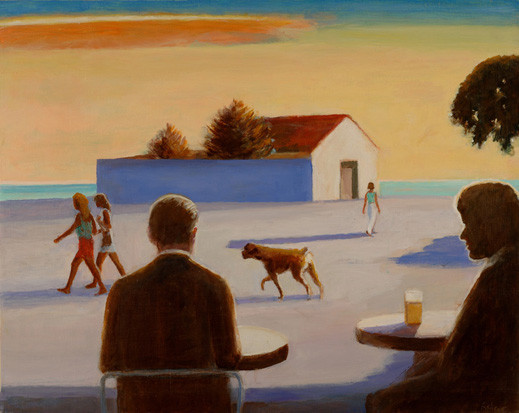Joaquín Pacheco
06 Jun - 26 Jul 2013
JOAQUÍN PACHECO
6 June - 26 July 2013
Paris, London and Amsterdam are some of the places where Joaquín Pacheco has lived (Madrid, 1934). If there is a distinctive trait about his nomadic artistic path, this is that since the 60s until today, his paintings have clearly shown vital signs that have remained there throughout his successive change of residency. The only area that has not abandoned is the canvas and acrylic that covers the surface– in which he has constantly taken over again a bipartite understanding of space ; the plane of earth and heaven. Contemplative figures in half-naked spaces contained in cinematographic framings that depict the lives of the characters presented, archetypical mannequins or human bodies and mostly passers-by.
The shades cast on the pavement by the anonymous heroes are visible in most of the paintings with equal neatness and gestural quality as their bodies, depicted in relaxed postures. The men and women brought to the canvas by the artist are noted for their lack of eloquence – they are devoid of any motion or body expression that might reflect any specific inner state. The subjects show some interest in the sight they are contemplating – the same interest of a viewer who has stopped to examine the work. The postures of the men in mackintoshes with their backs turned on us like the attitude of the woman sitting are similar to the physical position of any observer.
Sombras, Arquitectura and Ocaso are among the titles of the exhibition presented by Distrito 4, in which we find some of the pieces painted by Pacheco since 2010 until today. Through them, the artist is already naming that which belongs to his images: calmness. The paintings selected seem to affix “Small Waiting Stories” in a square, a staircase, in the beach, water and glass reflections.
The contours of the buildings appear enhanced by the tension of the conic perspective that Pacheco often uses to frame the scenes. The vanishing lines contrast with the volumes of a woman or a tree, with the slow masses of paint like the shapeless clouds painted on sunny days. Glazed walls, large windows that reveal the opacity of the people also disclosed at once. They are buildings that work as defined masses of inert life, like the rest areas and transitional places of one of the painters that are among his major influences, Edward Hopper. We might define Joaquín Pacheco’s works as painted images, for they refer to snapshots where people admire the scenario itself and seam to share it, in occasions he shows us the most unimportant moments of any person.
6 June - 26 July 2013
Paris, London and Amsterdam are some of the places where Joaquín Pacheco has lived (Madrid, 1934). If there is a distinctive trait about his nomadic artistic path, this is that since the 60s until today, his paintings have clearly shown vital signs that have remained there throughout his successive change of residency. The only area that has not abandoned is the canvas and acrylic that covers the surface– in which he has constantly taken over again a bipartite understanding of space ; the plane of earth and heaven. Contemplative figures in half-naked spaces contained in cinematographic framings that depict the lives of the characters presented, archetypical mannequins or human bodies and mostly passers-by.
The shades cast on the pavement by the anonymous heroes are visible in most of the paintings with equal neatness and gestural quality as their bodies, depicted in relaxed postures. The men and women brought to the canvas by the artist are noted for their lack of eloquence – they are devoid of any motion or body expression that might reflect any specific inner state. The subjects show some interest in the sight they are contemplating – the same interest of a viewer who has stopped to examine the work. The postures of the men in mackintoshes with their backs turned on us like the attitude of the woman sitting are similar to the physical position of any observer.
Sombras, Arquitectura and Ocaso are among the titles of the exhibition presented by Distrito 4, in which we find some of the pieces painted by Pacheco since 2010 until today. Through them, the artist is already naming that which belongs to his images: calmness. The paintings selected seem to affix “Small Waiting Stories” in a square, a staircase, in the beach, water and glass reflections.
The contours of the buildings appear enhanced by the tension of the conic perspective that Pacheco often uses to frame the scenes. The vanishing lines contrast with the volumes of a woman or a tree, with the slow masses of paint like the shapeless clouds painted on sunny days. Glazed walls, large windows that reveal the opacity of the people also disclosed at once. They are buildings that work as defined masses of inert life, like the rest areas and transitional places of one of the painters that are among his major influences, Edward Hopper. We might define Joaquín Pacheco’s works as painted images, for they refer to snapshots where people admire the scenario itself and seam to share it, in occasions he shows us the most unimportant moments of any person.

